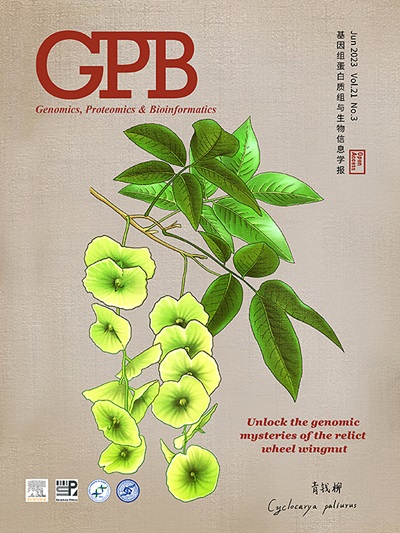stAPAminer:为空间解析转录组学研究挖掘选择性聚腺苷化的空间模式。
IF 7.9
2区 生物学
Q1 GENETICS & HEREDITY
引用次数: 0
摘要
选择性多腺苷酸化(APA)有助于转录组的复杂性和基因表达调控,并与各种细胞过程和疾病有关。单细胞RNA测序(scRNA-seq)使APA能够在单细胞水平上进行分析;然而,细胞的空间信息并没有保存在scRNA-seq中。或者,空间转录组学(ST)技术提供了破译转录组学景观的空间背景的机会。开拓性研究揭示了潜在的空间可变基因和/或剪接异构体;然而,APA在空间语境中的使用模式仍然没有得到重视。在这项研究中,我们开发了一个名为stAPAminer的工具包,用于从空间条形码ST数据中挖掘APA的空间模式。APA位点从ST数据中进行鉴定和定量。特别是,设计了一个基于k近邻算法的插补模型来恢复APA信号,然后识别出具有APA使用变异空间模式的APA基因。通过分析小鼠嗅球(MOB)的成熟ST数据,我们提供了跨MOB形态层的空间APA使用的详细视图。我们编制了一份具有空间APA动力学的基因的综合列表,并获得了几个主要的空间表达模式,这些模式代表了不同形态层中的空间APA动态。通过将该分析扩展到MOB ST数据的另外两个重复,我们观察到几个基因的空间APA模式在重复中是可重复的。stAPAminer利用ST的力量以空间分辨率探索空间APA模式的转录图谱。此工具包位于https://github.com/BMILAB/stAPAminer和https://ngdc.cncb.ac.cn/biocode/tools/BT007320.本文章由计算机程序翻译,如有差异,请以英文原文为准。
stAPAminer: Mining Spatial Patterns of Alternative Polyadenylation for Spatially Resolved Transcriptomic Studies
Alternative polyadenylation (APA) contributes to transcriptome complexity and gene expression regulation and has been implicated in various cellular processes and diseases. Single-cell RNA sequencing (scRNA-seq) has enabled the profiling of APA at the single-cell level; however, the spatial information of cells is not preserved in scRNA-seq. Alternatively, spatial transcriptomics (ST) technologies provide opportunities to decipher the spatial context of the transcriptomic landscape. Pioneering studies have revealed potential spatially variable genes and/or splice isoforms; however, the pattern of APA usage in spatial contexts remains unappreciated. In this study, we developed a toolkit called stAPAminer for mining spatial patterns of APA from spatially barcoded ST data. APA sites were identified and quantified from the ST data. In particular, an imputation model based on the k-nearest neighbors algorithm was designed to recover APA signals, and then APA genes with spatial patterns of APA usage variation were identified. By analyzing well-established ST data of the mouse olfactory bulb (MOB), we presented a detailed view of spatial APA usage across morphological layers of the MOB. We compiled a comprehensive list of genes with spatial APA dynamics and obtained several major spatial expression patterns that represent spatial APA dynamics in different morphological layers. By extending this analysis to two additional replicates of the MOB ST data, we observed that the spatial APA patterns of several genes were reproducible among replicates. stAPAminer employs the power of ST to explore the transcriptional atlas of spatial APA patterns with spatial resolution. This toolkit is available at https://github.com/BMILAB/stAPAminer and https://ngdc.cncb.ac.cn/biocode/tools/BT007320.
求助全文
通过发布文献求助,成功后即可免费获取论文全文。
去求助
来源期刊

Genomics, Proteomics & Bioinformatics
Biochemistry, Genetics and Molecular Biology-Biochemistry
CiteScore
14.30
自引率
4.20%
发文量
844
审稿时长
61 days
期刊介绍:
Genomics, Proteomics and Bioinformatics (GPB) is the official journal of the Beijing Institute of Genomics, Chinese Academy of Sciences / China National Center for Bioinformation and Genetics Society of China. It aims to disseminate new developments in the field of omics and bioinformatics, publish high-quality discoveries quickly, and promote open access and online publication. GPB welcomes submissions in all areas of life science, biology, and biomedicine, with a focus on large data acquisition, analysis, and curation. Manuscripts covering omics and related bioinformatics topics are particularly encouraged. GPB is indexed/abstracted by PubMed/MEDLINE, PubMed Central, Scopus, BIOSIS Previews, Chemical Abstracts, CSCD, among others.
 求助内容:
求助内容: 应助结果提醒方式:
应助结果提醒方式:


